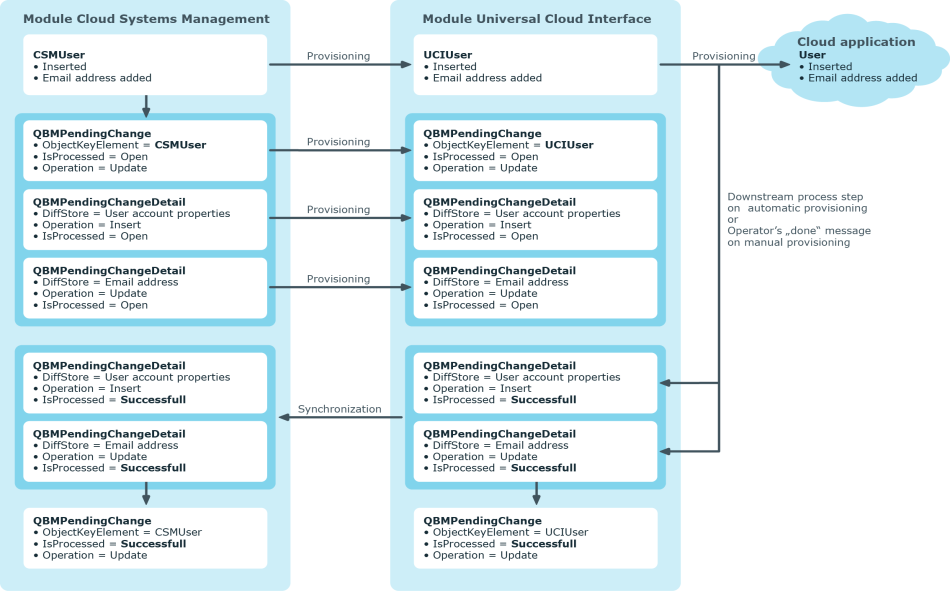Provisioning object changes
Changes to cloud objects can only be made in the Cloud Systems Management Module. Provisioning processes ensure that object changes are transferred from the Cloud Systems Management Module into the Universal Cloud Interface Module. By default, these object changes are then published in the cloud application by automatic provisioning processes.
One Identity Manager logs the object changes as pending changes in separate tables. The QBMPendingChange table contains the modified objects and their processing status. The details of the changes, operations to execute, time stamp and processing status are saved in the QBMPendingChangeDetail table.
The processing status of an object is not set to successful until all associated changes for this object have been successfully provisioned. An object's processing status is set as failed if all associated changes have been processed and at least one them has failed.
Detailed information about this topic
The provisioning sequence
The following image show how object changes are provisioned and how the pending changes associated with it are processed. The sequence does no depend on whether the module Cloud System Management and the Universal Cloud Interface are installed in the same or in separate databases.
Figure 3: Provisioning sequence for pending changes

By default, the Cloud Systems Management module is synchronized hourly with the Universal Cloud Interface. This ensures that the processing state for pending changes is declared promptly in the Cloud Systems Management Module.
Displaying pending changes
You can view pending changes in the Manager. Here, manual, and automatic provisioning processes are shown.
To display pending changes
- Select the menu item Database | Pending changes menu item.
Table 45: Meaning of the icons in the toolbar
|

|
Show selected object. |
|

|
Reload the data. |
Retention time for pending changes
Table 46: Configuration parameters
| QBM | PendingChange | LifeTimeError |
This configuration parameter specifies the maximum retention period (in days) for failed provisioning processes. Default is 30 days. |
| QBM | PendingChange | LifeTimeRunning |
This configuration parameter specifies the maximum retention period (in days) for open provisioning processes. Default is 60 days. |
| QBM | PendingChange | LifeTimeSuccess |
This configuration parameter specifies the maximum retention period (in days) for successful provisioning processes. Default is 2 days. |
Pending changes are saved for a fixed period. After this period has expired, the entries are deleted by the DBQueue Processor from the QBMPendingChange and QBMPendingChangeDetail tables. The retention period depends on the status of provisioning processes and can be configured in the configuration parameter.
To configure the retention period for pending changes
- To change the retention period for successful provisioning processes, in the Designer, edit the value of the "QBM | PendingChange | LifeTimeSuccess" configuration parameter.
- To change the retention period for failed provisioning processes, in the Designer, edit the value of the "QBM | PendingChange | LifeTimeError" configuration parameter.
- To change the retention period for open provisioning processes, in the Designer, edit the value of the "QBM | PendingChange | LifeTimeRunning" configuration parameter.
- Enter a retention period in days.



